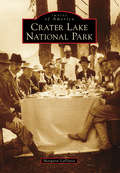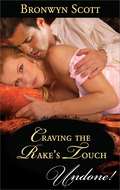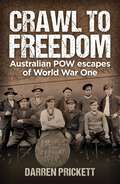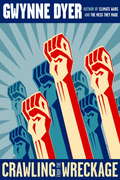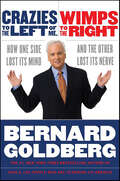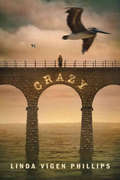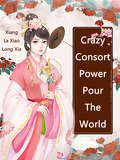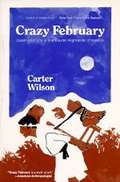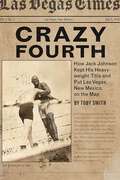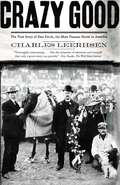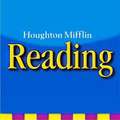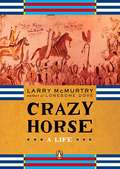- Table View
- List View
Crater Lake National Park
by Margaret LaplanteFor more than half a million years, volcano Mount Mazama towered over southern Oregon. From time to time, it erupted, spreading pumice, ash, and cinders for miles around. Then, approximately 7,700 years ago, Mount Mazama erupted with such force that the volcano could no longer support itself and it collapsed, leaving a large caldera. Eventually, the volcanic action subsided and all was calm. Over the next centuries, water and snow accumulated in the caldera. In 1902, Crater Lake became a national park.
Cratylus
by Plato C. D. Reeve"It is. . . remarkable that Reeve's is the first new English translation since Fowler's Loeb edition of 1926. Fortunately, Reeve has done an excellent job. His version is not slavishly literal but is in general very accurate. It is also very clear and readable. Reeve is particularly to be congratulated for having produced versions of some of the more torturous passages, which are not only faithful to the text but also make good sense in English. The long and detailed introduction is worth reading in its own right." --R. F. Stalley, The Classical Review
Craving the Highlander's Touch
by Michelle WillinghamScotland, 1306 For Alys Fitzroy, Lady of Harkirk, her brutish husband is more of an enemy than the wild Scots she is supposed to hate. Her heart longs to help her husband's prisoners—especially Finian MacLachor, the intense Highland chief who bears the scars of his own failed uprising, both inside and out. With her help, he has a second chance to make things right for his clan—and and to show Alys the nights of unbelievable pleasure she's been missing.
Craving the Rake's Touch
by Bronwyn ScottLondon, 1836Lady Sarah Dryden once dreamed of marrying for love. But with the threat of scandal looming over her whole family, she must secure a wealthy husband-and quickly! If only her heart didn't already belong to the irresistibly tempting, and entirely unsuitable, Benedict DeBreed...Despite his well-deserved reputation as one of London's most notorious rakes, Benedict wants nothing more than to claim Sarah as his bride. And before he loses her to another in a loveless marriage, he'll use his legendary powers of seduction to show her Lexactly what she could expect with him as a husband!
Crawfordsville (Images of America)
by William P. Helling Crawfordsville District Public LibraryCrawfordsville, founded in the early 1820s, has a diverse history for a small town located in rural, west-central Indiana. The town was the site of an important land office, which attracted many settlers, as well as speculators, to the area. Crawfordsville became known for its intellectual and progressive atmosphere and earned the nickname of the "Athens of Indiana," especially for the numerous residents with literary accomplishments. Wabash College was established in Crawfordsville in 1832, and the institution's teachers and students have contributed greatly to the development of the town's culture and prestige. In addition to its authors and poets, Crawfordsville has had its share of musicians, artists, soldiers, and statesmen who have played a role far beyond the borders of Montgomery County, of which Crawfordsville is the seat. Images of America: Crawfordsville is a photographic tour of the people and places that have marked this town from its early days. Some 200 historical images capture the town's development, along with its interesting, and often unique, accomplishments.
Crawl to Freedom: Australian POW Escapes of World War One
by Darren PrickettDuring World War One over 4000 Australian servicemen were taken prisoner. Yet the prisoner of war experiences of the Anzacs are frequently forgotten, treated as mere footnotes in the proliferation of the literature of Australian military history. Where individual stories have been told they are often from the perspective of life as a POW. It could be assumed that the Australian POWs of WWI passed quietly into captivity. The opposite was in fact the case. Many of the Anzacs attempted escape, with over 40 successfully making their way to England or across the battlefields of Western Europe to allied lines – to ultimately score home-runs! Crawl to Freedom is a collection of stories of those successful home-runs. From enlistment to capture, the journeys and efforts of the escapees are forensically explored as the Anzacs fight for their freedom. The astonishing stories tell of mateship, courage and determination in the face of adversity, these soldiers succeeded in overcoming their hardships to fulfill their ingenious endeavours to escape.Crawl to Freedom combines meticulous research with a forensic analysis to tell these astonishing stories of daring, perseverance and endurance ... stories crying out to be told for over 100 years!
Crawling from the Wreckage
by Gwynne DyerGwynne Dyer is cheering up. Sure, the past decade has had more than its share of stupid wars, obsessions about terrorism, denial about climate change, rapacious turbo-capitalism, and lies, lies, lies. But signs of progress actually do abound. While the world is far from perfect as we embark on a fresh decade, Dyer believes that the "sense of sliding out of control towards ten different kinds of disaster has gone." When things go wrong it's always easy to pin blame -- but singling out the forces that lead to positive change can be trickier.In this illuminating collection of columns from the last five years, Gwynne Dyer ferrets out the signs of hope -- without overlooking the issues that remain seemingly intractable. Mining the events of recent history, Dyer contextualizes the recent past and anticipates what the future might have in store. This journalist's beat is global: from Africa to South America, from Europe to the Middle East, and any other region with a political pulse. Acerbic and iconoclastic, Dyer has never been afraid to call 'em like he sees 'em -- and we are all the better for his trademark candour and the breadth of his knowledge and expertise. For anyone seeking to understand the larger forces that shape our society and our world, Crawling from the Wreckage makes for necessary reading.From the Hardcover edition.
Crayola: A Visual Biography of the World's Most Famous Crayon
by Crayola LLC Lisa SolomonA vibrant and colorful history of Crayola crayons, from the company's origin story, the birth of the Crayola crayon, the evolution of the iconic crayon packages, and profiles of every Crayola color from Sky Blue to Carnation Pink. Everyone has a relationship with color. If you think back to your first memories of exploring color, there is a very good chance that crayons were involved. And when it comes to crayons, Crayola is king.This book explores the history of a beloved childhood art supply, while also delving into our relationship with color: how we use and create with color, and how we name colors. It looks at the history of the 120 iconic colors of Crayola and where they came from, and how Crayola itself has helped shape our understanding of color over the last century and a half. Finally, this book explores how people -- adults and children alike -- have and continued to turn to Crayola to inspire and manifest their creativity. Filled with hundreds of illustrations and archival photos, Crayola is a nostalgic and fascinating wonderland of creativity and delight.
Crazies to the Left of Me, Wimps to the Right: How One Side Lost Its Mind and the Other Lost Its Nerve
by Bernard GoldbergEnough of the leftist lunatics like Rosie O'Donnell who think "Radical Christians" are "as big a threat to America as Radical Muslims." Enough of the hyperbolic liberal rhetoric comparing Bush to Saddam and Mel Gibson to Hitler. Enough of the hyper-partisan, ultra-PC liberal media, which often seem more sympathetic to the "victims of humiliation" at Abu Ghraib than to our troops dying at the hands of Iraqi fundamentalists. Enough, too, of the gutless wonders on the right who don't have the courage to stand up for their own convictions. Enough of their pandering, trolling for votes, and outspending the Democrats. Now with powerful and provocative new material, Bernard Goldberg's Crazies to the Left of Me, Wimps to the Right sounds an even louder alarm than before—warning that, if the wimps on the right don't regain their courage and reclaim their principles, the crazies on the left just might win the White House in '08.
Crazy
by Linda Vigen PhillipsA compelling novel in verse about mental illness Laura is a typical fifteen-year-old growing up in the 1960s, navigating her way through classes, friendships, and even a new romance. But she&’s carrying around a secret: her mother is suffering from a mental illness. No one in Laura&’s family will talk about her mother&’s past hospitalizations or increasingly erratic behavior, and Laura is confused and frightened. Laura finds some refuge in art, but when her mother suffers a breakdown after taking painting back up again herself, even art ceases to provide much comfort. Eloquent and compelling, this powerful novel-in-verse tackles complex themes in a way that will have readers rooting for Laura to find the courage to get the answers she needs.
Crazy '08: How a Cast of Cranks, Rogues, Boneheads, and Magnates Created the Greatest Year in Baseball History
by Cait N. MurphyFrom the perspective of 2007, the unintentional irony of Chance's boast is manifest—these days, the question is when will the Cubs ever win a game they have to have. In October 1908, though, no one would have laughed: The Cubs were, without doubt, baseball's greatest team—the first dynasty of the 20th century.Crazy '08 recounts the 1908 season—the year when Peerless Leader Frank Chance's men went toe to toe to toe with John McGraw and Christy Mathewson's New York Giants and Honus Wagner's Pittsburgh Pirates in the greatest pennant race the National League has ever seen. The American League has its own three-cornered pennant fight, and players like Cy Young, Ty Cobb, Walter Johnson, and the egregiously crooked Hal Chase ensured that the junior circuit had its moments. But it was the National League's—and the Cubs'—year. Crazy '08, however, is not just the exciting story of a great season. It is also about the forces that created modern baseball, and the America that produced it. In 1908, crooked pols run Chicago's First Ward, and gambling magnates control the Yankees. Fans regularly invade the field to do handstands or argue with the umps; others shoot guns from rickety grandstands prone to burning. There are anarchists on the loose and racial killings in the town that made Lincoln. On the flimsiest of pretexts, General Abner Doubleday becomes a symbol of Americanism, and baseball's own anthem, "Take Me Out to the Ballgame," is a hit. Picaresque and dramatic, 1908 is a season in which so many weird and wonderful things happen that it is somehow unsurprising that a hairpiece, a swarm of gnats, a sudden bout of lumbago, and a disaster down in the mines all play a role in its outcome. And sometimes the events are not so wonderful at all. There are several deaths by baseball, and the shadow of corruption creeps closer to the heart of baseball—the honesty of the game itself. Simply put, 1908 is the year that baseball grew up.Oh, and it was the last time the Cubs won the World Series.Destined to be as memorable as the season it documents, Crazy '08 sets a new standard for what a book about baseball can be.
Crazy Consort Power Pour The World: Volume 1 (Volume 1 #1)
by Xiang LaxiaolongxiaShe was the young lady of the Prime Minister's Estate, as well as the princess of His Majesty's residence. However, he had been neglected by his father due to his frail and sickly body, as well as his lack of talent in martial arts. His father didn't hurt, his aunt bullied him, and they schemed against each other. In the end, they died miserably in a small courtyard, and their bodies were almost turned into puppets. Her movements were strange, her killing intent decisive. She was the king of assassins in the world, but because of a blood jade she allowed her soul to pass through. On the day that the King of Assassins became the daughter of the Prime Minister, the winds and clouds changed, the stars became chaotic, and the guardian beast became anxious. Even though the Imperial Scholar could not predict what would happen next, he suffered a backlash. The people said that the gods had descended from the heavens, so they couldn't peep. What she wanted was very simple. She wanted a world where one could come and go as they wished, a world where all living beings bowed down to others, and a man who loved others without equal. [Previous Chapter] [Table of Contents] [Next Chapter]
Crazy Consort Power Pour The World: Volume 2 (Volume 2 #2)
by Xiang LaxiaolongxiaShe was the young lady of the Prime Minister's Estate, as well as the princess of His Majesty's residence. However, he had been neglected by his father due to his frail and sickly body, as well as his lack of talent in martial arts. His father didn't hurt, his aunt bullied him, and they schemed against each other. In the end, they died miserably in a small courtyard, and their bodies were almost turned into puppets. Her movements were strange, her killing intent decisive. She was the king of assassins in the world, but because of a blood jade she allowed her soul to pass through. On the day that the King of Assassins became the daughter of the Prime Minister, the winds and clouds changed, the stars became chaotic, and the guardian beast became anxious. Even though the Imperial Scholar could not predict what would happen next, he suffered a backlash. The people said that the gods had descended from the heavens, so they couldn't peep. What she wanted was very simple. She wanted a world where one could come and go as they wished, a world where all living beings bowed down to others, and a man who loved others without equal. [Previous Chapter] [Table of Contents] [Next Chapter]
Crazy Consort Power Pour The World: Volume 3 (Volume 3 #3)
by Xiang LaxiaolongxiaShe was the young lady of the Prime Minister's Estate, as well as the princess of His Majesty's residence. However, he had been neglected by his father due to his frail and sickly body, as well as his lack of talent in martial arts. His father didn't hurt, his aunt bullied him, and they schemed against each other. In the end, they died miserably in a small courtyard, and their bodies were almost turned into puppets. Her movements were strange, her killing intent decisive. She was the king of assassins in the world, but because of a blood jade she allowed her soul to pass through. On the day that the King of Assassins became the daughter of the Prime Minister, the winds and clouds changed, the stars became chaotic, and the guardian beast became anxious. Even though the Imperial Scholar could not predict what would happen next, he suffered a backlash. The people said that the gods had descended from the heavens, so they couldn't peep. What she wanted was very simple. She wanted a world where one could come and go as they wished, a world where all living beings bowed down to others, and a man who loved others without equal. [Previous Chapter] [Table of Contents] [Next Chapter]
Crazy February: Death and Life in the Mayan Highlands of Mexico
by Carter WilsonProducts of the "imagination," such as novels, can be especially useful tools for understanding how things work in societies far removed from our own experience. Through the telling of a story, a sound ethnographic novel conveys more than information. It involves the reader in the dynamics of life in places where the rules for action are very different from the rules the reader makes his own decisions by. Some people believe ethnographic novels are comparable to fieldnotes- the data themselves in their original, unanalyzed form. Though I can see the reason for the analogy, the author still disagree with it. Good fieldnotes record raw experience. For the time being, the anthropologist squelches his desire to interpret, and he writes down everything he can see or remember. Good ethnographic fiction also presents experience raw, without generalization. But in building the story, in selecting to tell this because it is important and not to tell that because it seems trivial, the novelist is analyzing his material. Between the raw and the cooked, both ethnographies and ethnographic novels belong in the processed pot. Anthropologists try to make explicit and public both the method they have used to gather their material and the means for analyzing it. Ordinarily, a novelist obscures his analysis-the grounds for the choices he has made-and depends on the interior logic of the story to make his tale seem "true" or "believable. " But Crazy February works with somewhat different principles than the author would normally use in writing "fiction. " The book grew directly out of field experience. Wilson felt strongly that it would stand or fall on its ethnographic correctness. And so, faced with choices between what the author would like to see in the story and what he thought would actually happen to an Indian in the mountains of Chiapas, he consistently chose "actuality. " In a practical, day-to-day writing sense, reality was the author's rod and my staff. And in the end he was very happy when anthropologists with greater experience in the Mayan area found the book essentially exact and, more important, true to the spirit of the place he had written about.
Crazy Fourth: How Jack Johnson Kept His Heavyweight Title and Put Las Vegas, New Mexico, on the Map
by Toby SmithIn 1912 boxing was as popular a spectator sport in the United States as baseball, if not more so. It was also rife with corruption and surrounded by gambling, drinking, and prostitution, so much so that many cities and states passed laws to control it. But not in New Mexico. It was the perfect venue for one of the biggest, loudest, most rambunctious heavyweight championship bouts ever seen. In Crazy Fourth Toby Smith tells the story of how the African American boxer Jack Johnson—the bombastic and larger-than-life reigning world heavyweight champion—met Jim Flynn on the fourth of July in Las Vegas, New Mexico. The civic boosters, bursting with pride in their town, raised a hundred thousand dollars for the fight, pushing events like the sinking of the Titanic to the back pages of every newspaper. In the end, once the dust finally settled on the whole unseemly spectacle, Las Vegas would spend the next generation making good on its losses.
Crazy Good: The True Story of Dan Patch, the Most Famous Horse in America
by Charles LeerhsenA hundred years ago, the most famous athlete in America was a horse. But Dan Patch was more than a sports star; he was a cultural icon in the days before the automobile. Born crippled and unable to stand, he was nearly euthanized. For a while, he pulled the grocer's wagon in his hometown of Oxford, Indiana. But when he was entered in a race at the county fair, he won -- and he kept on winning. Harness racing was the top sport in America at the time, and Dan, a pacer, set the world record for the mile. He eventually lowered the mark by four seconds, an unheard-of achievement that would not be surpassed for decades. America loved Dan Patch, who, though kind and gentle, seemed to understand that he was a superstar: he acknowledged applause from the grandstands with a nod or two of his majestic head and stopped as if to pose when he saw a camera. He became the first celebrity sports endorser; his name appeared on breakfast cereals, washing machines, cigars, razors, and sleds. At a time when the highest-paid baseball player, Ty Cobb, was making $12,000 a year, Dan Patch was earning over a million dollars. But even then horse racing attracted hustlers, cheats, and touts. Drivers and owners bet heavily on races, which were often fixed; horses were drugged with whiskey or cocaine, or switched off with "ringers. " Although Dan never lost a race, some of his races were rigged so that large sums of money could change hands. Dan's original owner was intimidated into selling him, and America's favorite horse spent the second half of his career touring the country in a plush private railroad car and putting on speed shows for crowds that sometimes exceeded 100,000 people. But the automobile cooled America's romance with the horse, and by the time he died in 1916, Dan was all but forgotten. His last owner, a Minnesota entrepreneur gone bankrupt, buried him in an unmarked grave. His achievements have faded, but throughout the years, a faithful few kept alive the legend of Dan Patch, and inCrazy Good, Charles Leerhsen travels through their world to bring back to life this fascinating story of triumph and treachery in small-town America and big-city racetracks.
Crazy Good: The True Story of Dan Patch, the Most Famous Horse in America
by Charles LeerhsenA hundred years ago, the most famous athlete in America was a horse. But Dan Patch was more than a sports star; he was a cultural icon in the days before the automobile. Born crippled and unable to stand, he was nearly euthanized. For a while, he pulled the grocer's wagon in his hometown of Oxford, Indiana. But when he was entered in a race at the county fair, he won -- and he kept on winning. Harness racing was the top sport in America at the time, and Dan, a pacer, set the world record for the mile. He eventually lowered the mark by four seconds, an unheard-of achievement that would not be surpassed for decades. America loved Dan Patch, who, though kind and gentle, seemed to understand that he was a superstar: he acknowledged applause from the grandstands with a nod or two of his majestic head and stopped as if to pose when he saw a camera. He became the first celebrity sports endorser; his name appeared on breakfast cereals, washing machines, cigars, razors, and sleds. At a time when the highest-paid baseball player, Ty Cobb, was making $12,000 a year, Dan Patch was earning over a million dollars. But even then horse racing attracted hustlers, cheats, and touts. Drivers and owners bet heavily on races, which were often fixed; horses were drugged with whiskey or cocaine, or switched off with "ringers." Although Dan never lost a race, some of his races were rigged so that large sums of money could change hands. Dan's original owner was intimidated into selling him, and America's favorite horse spent the second half of his career touring the country in a plush private railroad car and putting on speed shows for crowds that sometimes exceeded 100,000 people. But the automobile cooled America's romance with the horse, and by the time he died in 1916, Dan was all but forgotten. His last owner, a Minnesota entrepreneur gone bankrupt, buried him in an unmarked grave. His achievements have faded, but throughout the years, a faithful few kept alive the legend of Dan Patch, and in Crazy Good, Charles Leerhsen travels through their world to bring back to life this fascinating story of triumph and treachery in small-town America and big-city racetracks.
Crazy Horse #5
by Ann Hood Denis ZilberThe New York Times calls Ann Hood's thrilling The Treasure Chest series "delightful!" In book five, Felix and Maisie re-enter The Treasure Chest and suddenly find themselves in the midst of a Lakota village. While exploring they meet a young man, soon to be known as Crazy Horse--and embark on an adventure that includes fascinating vision quests and exciting battles.
Crazy Horse (Houghton Mifflin Harcourt Vocabulary Readers #Leveled Reader: Level: 5, Theme: 5.1)
by Rob AregoIntroduction to Crazy Horse, the famous Native American warrior.
Crazy Horse and Custer: The Parallel Lives of Two American Warriors
by Stephen E. AmbroseA New York Times bestseller from the author of Band of Brothers: The biography of two fighters forever linked by history and the battle at Little Bighorn. On the sparkling morning of June 25, 1876, 611 men of the United States 7th Cavalry rode toward the banks of Little Bighorn in the Montana Territory, where three thousand Indians stood waiting for battle. The lives of two great warriors would soon be forever linked throughout history: Crazy Horse, leader of the Oglala Sioux, and General George Armstrong Custer. Both were men of aggression and supreme courage. Both became leaders in their societies at very early ages. Both were stripped of power, in disgrace, and worked to earn back the respect of their people. And to both of them, the unspoiled grandeur of the Great Plains of North America was an irresistible challenge. Their parallel lives would pave the way, in a manner unknown to either, for an inevitable clash between two nations fighting for possession of the open prairie.
Crazy Horse's Vision (Live Oak Media Ereadalong Ser.)
by Joseph BruchacThe true story of the great Sioux warrior who, as a young boy, defies tradition and seeks a vision on his own in hopes of saving his people.Crazy Horse is among the best known Native American heroes. Yet many people do not know his boyhood name was Curly, inspired by his curly hair. Curly was a leader even as a young boy, taming wild horses and hunting powerful buffalo. But all his bravery could not prepare him for the trouble he and the other Lakota Indians would face with the white settlers. Wanting to help his people after a fierce battle that mortally wounded Chief Conquering Bear, Curly defied traditional custom and risked his own life by running away, up to the hills, to seek a vision. Renowned Abenaki author Joseph Bruchac tells a gripping and compelling story of how the dedicated young boy, Curly, grows into the brave warrior Crazy Horse. Sioux artist S.D. Nelson, with paintings inspired by the ledger book style of the Plains Indians, evokes the drama and tragedy of an important figure in American history.
Crazy Horse: A Life (Basic Ser. #Vol. 2)
by Larry McmurtryLegends cloud the life of Crazy Horse, a seminal figure in American history but an enigma even to his own people in his own day. This superb biography looks back across more than 120 years at the life and death of this great Sioux warrior who became a reluctant leader at the Battle of Little Bighorn. With his uncanny gift for understanding the human psyche, Larry McMurtry animates the character of this remarkable figure, whose betrayal by white representatives of the U.S. government was a tragic turning point in the history of the West. A mythic figure puzzled over by generations of historians, Crazy Horse emerges from McMurtry's sensitive portrait as the poignant hero of a long-since-vanished epoch.
Crazy Horse: The Invincible Ogalalla Sioux Chief
by E. A. BrininstoolOriginally published in 1949, this book is a gripping collection of reminiscences on the death of the great Indian chief, Crazy Horse, by the military men who were present on that fateful day on September 5, 1877 at old Fort Robinson, Nebraska: Jesse M. Lee , V. T. McGillycuddy, H. R. Lemly, and George McAnulty.Crazy Horse was one of the “irreconcilables” of the Sioux, an Indian who refused to be “reconstructed” and follow the white man’s road. Like Sitting Bull he had little or no use for the white man, and especially those in authority at Washington. This is not surprising, considering the unjust treatment the Indian received, and the trickery and deceit practiced upon him.Although but a young man, even at the time of his treacherous murder, Crazy Horse had already won his spurs in the defeat of Col. J. J. Reynolds in the Powder River fight of March 17, 1876, and of his practical defeat of General George Crook’s forces in the Rosebud fight of June 17, 1876, to say nothing of the leading part he played in the annihilation of Custer’s immediate command of five troops of the Seventh Cavalry, June 25, 1876, at the battle of the Little Big Horn, in South-eastern Montana. After all these brilliant “coups” the reputation of Crazy Horse, as a fighting chief, inspiring leader and strategist, was secure among his own people.
Crazy Horse: The Lakota Warrior's Life & Legacy
by The Edward Clown Family&“A family account of the life of Tashunke Witko, their great Sioux relative . . . For the first time, the Clown family members tell their oral history.&”—True West The Edward Clown family, nearest living relatives to the Lakota war leader, presents the family tales and memories told to them about their famous grandfather. In many ways the oral history differs from what has become the standard and widely accepted biography of Crazy Horse. The family clarifies the inaccuracies and shares their story about the past, including what it means to them to be Lakota, the family genealogy, the life of Crazy Horse and his motivations, his death, and why they chose to keep quiet with their knowledge for so long before finally deciding to tell the truth as they know it. This book is a compelling addition to the body of works about Crazy Horse and the complicated and often conflicting events of that time period in American History. &“For the first time the first-hand account of Crazy Horse is told . . . The stories were faithfully passed down through the generations . . . It includes Crazy Horse&’s account of the last moments of Custer and the near-killing of Maj. Marcus Reno by Crazy Horse&’s father.&”—Capital Journal &“After many years of keeping quiet, the family of Lakota warrior Crazy Horse decided to tell their story of his life and legacy . . . The truth behind the history of Crazy Horse—an iconic Native American warrior—until recently has been kept hidden for more than a century.&”—The Monroe News
